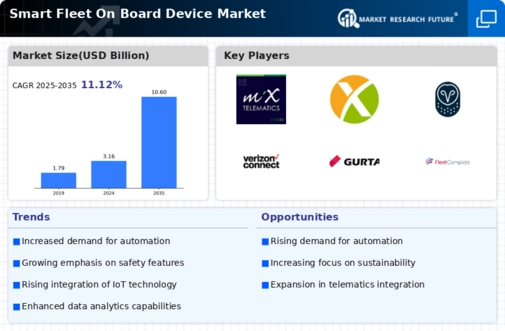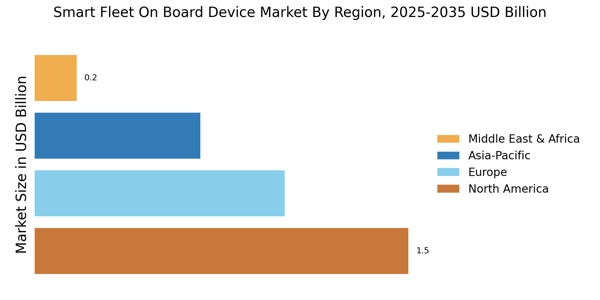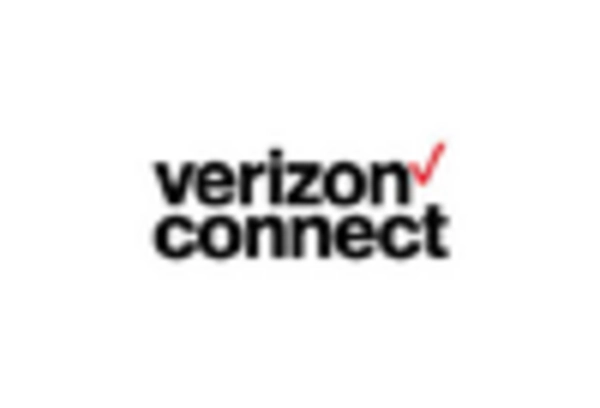Rising Demand for Fleet Efficiency
The Smart Fleet On Board Device Market is experiencing a notable surge in demand for enhanced fleet efficiency. Companies are increasingly recognizing the importance of optimizing their operations to reduce costs and improve service delivery. According to recent data, organizations utilizing smart fleet technologies have reported up to a 20% reduction in operational costs. This trend is driven by the need for real-time tracking and data analytics, which enable fleet managers to make informed decisions. As competition intensifies, the adoption of smart devices becomes essential for maintaining a competitive edge. The integration of advanced telematics and data-driven insights is likely to further propel the market, as businesses seek to streamline their logistics and improve overall productivity.
Regulatory Compliance and Safety Standards
The Smart Fleet On Board Device Market is significantly influenced by the increasing regulatory compliance requirements across various regions. Governments are implementing stringent safety standards aimed at reducing accidents and enhancing road safety. For instance, regulations mandating the installation of electronic logging devices (ELDs) have led to a marked increase in the adoption of smart fleet technologies. This compliance not only ensures safety but also helps companies avoid hefty fines associated with non-compliance. The market is projected to grow as more jurisdictions adopt similar regulations, compelling fleet operators to invest in smart devices that facilitate adherence to these standards. Consequently, the demand for innovative solutions that meet regulatory requirements is likely to drive market expansion.
Advancements in Telematics and Connectivity
The Smart Fleet On Board Device Market is witnessing rapid advancements in telematics and connectivity technologies. Innovations such as 5G networks and enhanced GPS capabilities are enabling more reliable and faster data transmission. This technological evolution allows fleet operators to monitor vehicle performance, driver behavior, and maintenance needs in real-time. As a result, companies can proactively address issues before they escalate, thereby reducing downtime and maintenance costs. The market is expected to benefit from these advancements, as they enhance the functionality and appeal of smart fleet devices. Furthermore, the integration of artificial intelligence and machine learning into telematics systems is likely to provide deeper insights, further driving the adoption of smart fleet technologies.
Growing Emphasis on Environmental Sustainability
The Smart Fleet On Board Device Market is increasingly shaped by the growing emphasis on environmental sustainability. Companies are under pressure to reduce their carbon footprints and adopt greener practices. Smart fleet technologies facilitate this transition by optimizing routes, reducing fuel consumption, and minimizing emissions. Data indicates that fleets utilizing smart devices can achieve up to a 15% reduction in fuel usage, contributing to sustainability goals. As businesses strive to align with environmental regulations and consumer expectations, the demand for smart fleet solutions is likely to rise. This trend not only supports corporate social responsibility initiatives but also enhances brand reputation, making sustainability a key driver in the market.
Increased Investment in Fleet Management Solutions
The Smart Fleet On Board Device Market is benefiting from increased investment in fleet management solutions. Companies are recognizing the value of investing in technologies that enhance operational efficiency and improve customer satisfaction. Recent statistics suggest that the fleet management software market is projected to grow at a compound annual growth rate of over 10% in the coming years. This investment trend is driven by the need for better visibility and control over fleet operations. As businesses seek to leverage data analytics and automation, the demand for smart fleet devices is expected to rise. This influx of capital into fleet management solutions is likely to foster innovation and drive the development of more sophisticated smart fleet technologies.


















Leave a Comment